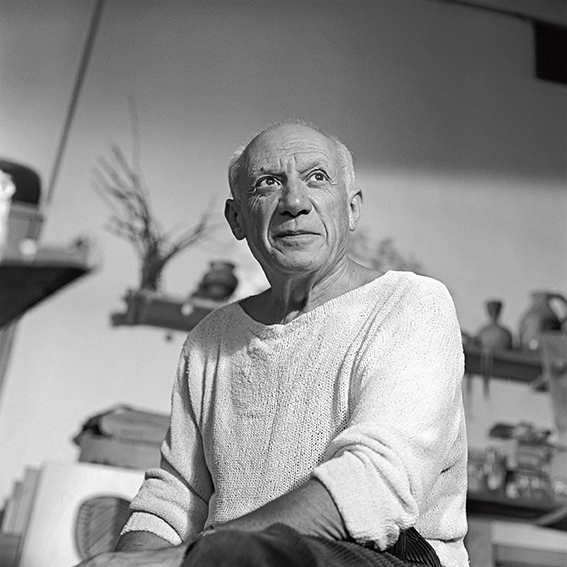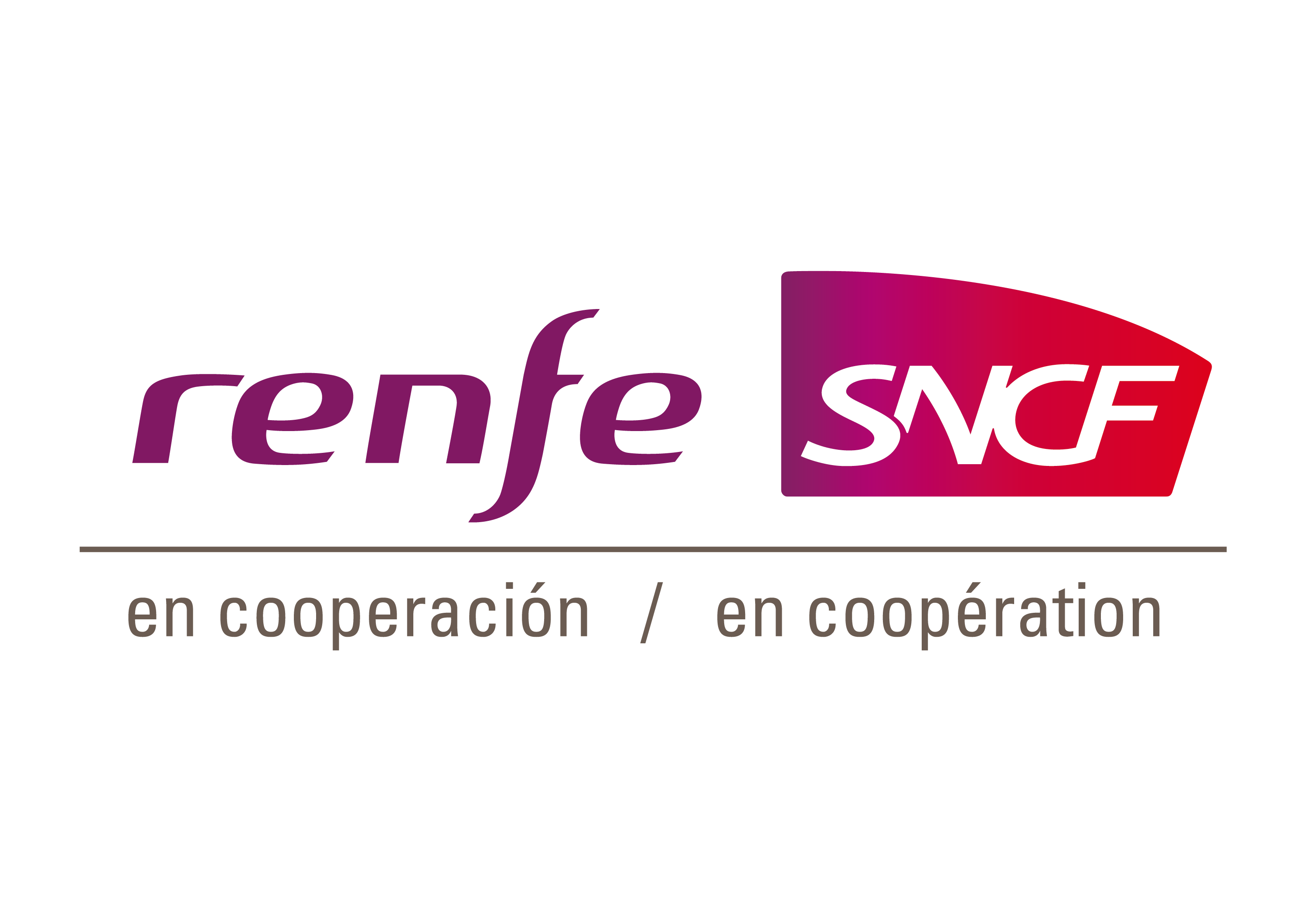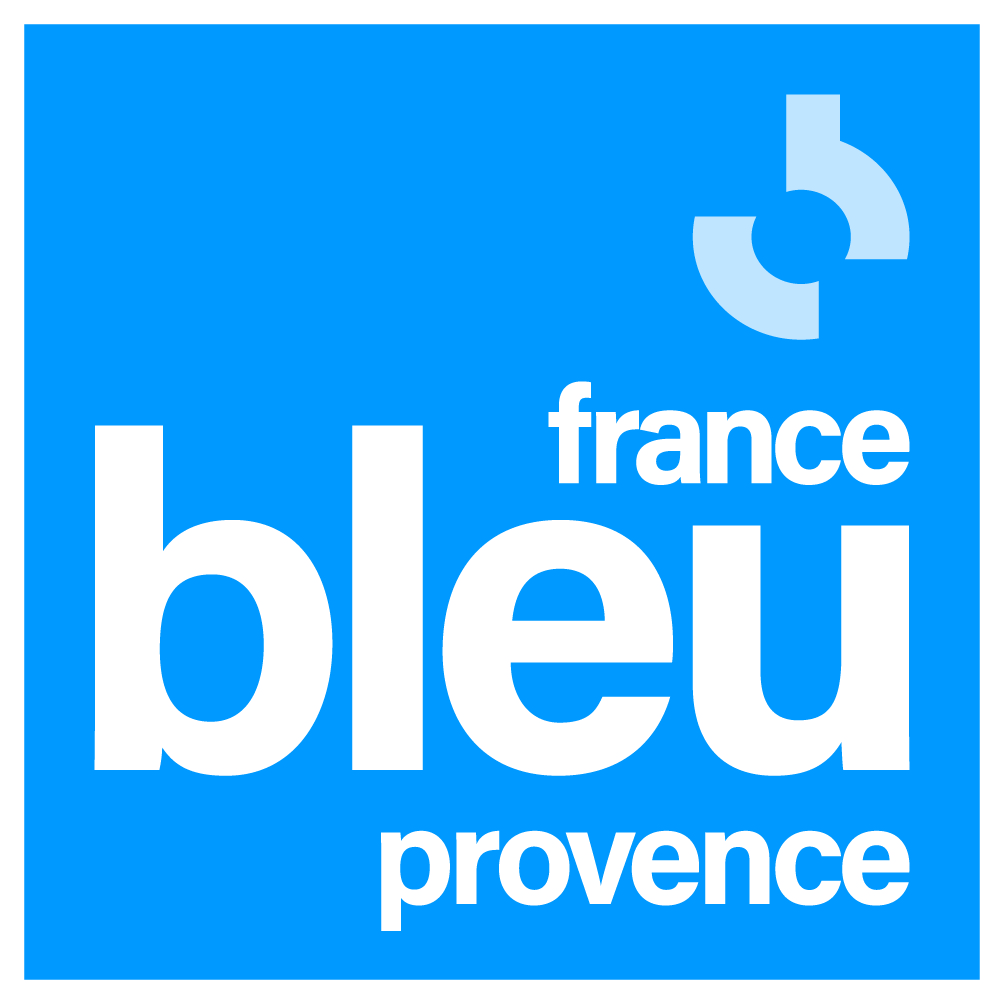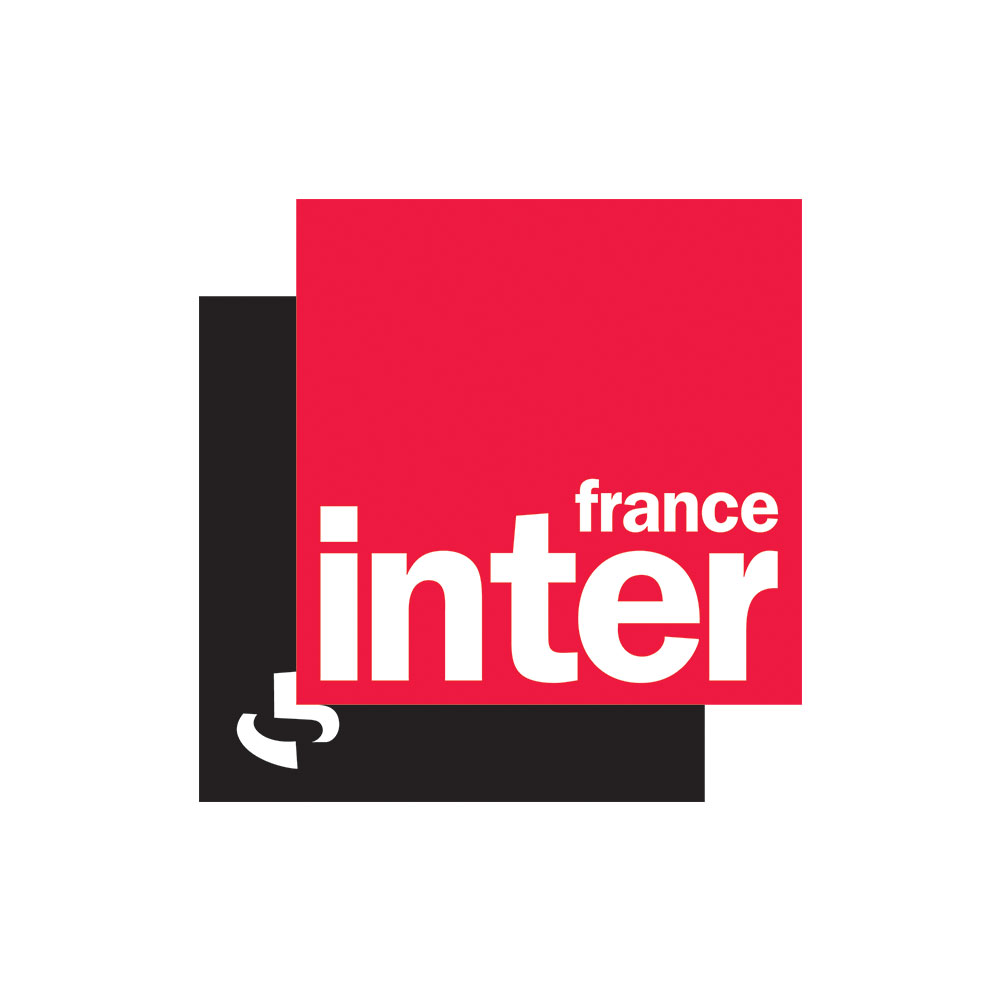Picasso, « a genius without a pedestal »
Picasso and popular arts and traditions
Mucem, J4—
Niveau 2
|
From Wednesday 27 April 2016 to Monday 29 August 2016
“Art obliges the artist not to keep himself apart; it subjects him to the most humble and the most universal truth. That is why true artists scorn nothing…”
Albert Camus. From his acceptance speech for the Nobel Prize in Literature, delivered in Oslo, Sweden on 10 December 1957.
From 27 April to 29 August 2016, the Mucem presents a major exhibition of 270 works demonstrating how Picasso, both established in his era and attached to his roots, nurtured his influences stemming from the popular arts and traditions. The exhibition itinerary, divided into four parts, mirrors the artist’s masterpieces with reference-objects from the rich collections of the Mucem. Benefiting from exceptional loans and support from public and private collections, both French and international, including a rich partnership with the Musée National Picasso-Paris, the exhibition brings together essential and iconic works, placed in perspective with surprising discoveries.
After evoking the sacred aspects of these primarily Spanish sources, the exhibition highlights how the artist drew inspiration from his memories. The themes and motifs, reoccurring memories in Picasso’s work, are thus illustrated by examples that represent his particular fascinations with the worlds of adornment (Jacqueline with Mantilla), music, the circus (Blue Acrobat), bullfighting (Bull’s Head), and toys.
The exhibition is built around Picasso’s encounters with various artisans, whose established expertise nourished his own experience and research. Thus the artist made successive incursions into the domains of woodworking (Paco Durrio), ceramics (Suzanne and Georges Ramié at the studio Madoura), silversmithing (François Hugo), linocutting (Hidalgo Arnera), filmmaking (Robert Picault), textiles (Marie Cuttoli), and sheet-metal (Lionel Prejger).
His utilisation of the everyday in its most prosaic (discarded items), but also most personal dimensions is expressed by a very beautiful group of constructions or assembled sculptures (Baboon and Young) where the gleaned objects and recycled materials are easily recognised.
Twentieth century art often toyed with its origins to construct a new relationship with the world. Picasso’s roots were multiple. Among these foundations, the environment of his childhood was very fertile ground. The everyday objects that Georges Henri Rivière honoured in the Musée des Arts et Traditions Populaires, which he founded in 1937, infinitely influenced the affective and aesthetic background of the artist. The collections of the Mucem that punctuate this exhibition itinerary were chosen from those acquired by Georges Henri Rivière, like so many echoes of the work of Picasso. With this knowledge at once intimate and universal, Picasso asserted himself as the true signal of a new popular culture.
General Curators:
Joséphine Matamoros, Chief Curator of Heritage, former Director of the Musée d’Art Moderne de Céret, Director of the Musée d’Art Moderne de Collioure
Bruno Gaudichon, Chief Curator of Heritage, Curator of La Piscine- Musée d’Art et d’Industrie André Diligent in Roubaix
Emilie Girard, Curator of Heritage, Director of the Centre for Conservation and Resources of the Mucem
Scenography: Jacques Sbriglio, Architect, Scenographer
With the generous support of the Musée National Picasso-Paris
With support from the La Fondation PwC France et Afrique Francophone pour la Culture et la Solidarité, founding sponsor of the Mucem.
Interview with the curators of the exhibition Joséphine Matamoros and Bruno Gaudichon
What popular arts and traditions are echoed in the work of Picasso?
Picasso was very marked by his roots. The perennial nature of these popular sources intervenes in two ways: through the reoccurring themes in his work, related to popular and cultural practices (the mantilla worn by Spanish women, musical instruments, the circus, bullfighting, pigeon keeping, etc.), but also by this preoccupation that animated him at the end of the war, of developing his work through forays into new domains like arts and crafts (ceramics, silversmithing, linocutting, etc.). Lastly, it seemed important to us to demonstrate his approach to sculpture, particularly after the war, in a period for ripe for research: thus he created constructions using found objects, simple popular objects. One of the most famous is the Bull’s Head (1942), created with a handlebar and a bicycle seat. What is interesting is that he does not set out to make the work; it is the found object that becomes the stimulus. The point is not for him to make something, but to translate the evocative power of the object.
“The point is not for him to make something, but to translate the evocative power of the object.”
In the exhibition, how will the mirroring of works by Picasso with objects from the collections of the Mucem operate?
Showing the objects that directly inspired Picasso is obviously impossible because they were swallowed into the works themselves. But we have been able to find in the collections of the Mucem objects that can fully illustrate his preoccupations. So, in each exhibition hall, a few objects will be presented first, echoing the theme to be addressed. Finally, recall that Picasso has ties to the Mucem: he knew Georges Henri Rivière, the founder of the Musée des Arts et Traditions Populaires (whose collections are now at the Mucem), at a time when the popular object was rightly being reconsidered: “museum-ified” by Rivière and rendered sacred by Picasso through its integration into his work.
This exhibition proposes a new way of interpreting the work of Picasso…
Clearly, retrospective for artists like Picasso, no longer really makes sense. Thus we propose a new way of interpreting his work that has never been explored. This question of the importance of popular arts and traditions in the artist’s work allows us to create a new approach to the exploration of Picasso.
The exhibition blends masterpieces with pieces that have never been seen. A few examples?
We indeed have important and famous works, particularly in the hall of assembled sculptures, constructions like Baboon and Young, whose head is made from two small cars that Picasso pilfered from his son: it is an icon. Not to mention the painting The Acrobat, a magnificent work, deeply anchored in his passion for the circus. As for the previously unseen or little known pieces, they are numerous: for example the set of tiles created by Picasso with Derain, presented in France for the first time; or the three silver dishes, compotiers, made with François Hugo, which should surprise many. Without forgetting the series of linocut posters created for the annual exhibition of Vallauris ceramics. We have them all, and this is a first. And then these large bullfighting paintings, absolutely extraordinary, and very rarely seen… We have benefited from a large number of loans from private collections, allowing us to feature very rare pieces.
What has struck you the most during your research for this exhibition?
The fact that this new manner of interpretation became a reality. We have confirmed that this question of the impact of popular arts and traditions on Picasso’s work bears weight. Throughout our research, while gradually unwinding the thread, certain things took on new meaning. We reread Sabartès’ texts in which he evokes a particular painting by Picasso’s father, Le Pigeonnier (The Dovecote), as a key element for the artist; and his passion for pigeon keeping would be reflected later in a magnificent set of works. The matrix of his childhood had a huge and clear impact on his themes and his techniques. Picasso never saw the Pigeonnier again after childhood (he vowed never to return to Spain while Franco was in power). But we have found it, and it is presented in the exhibition.
Between the circus, music and bullfighting, and from arts and crafts to sculpture, this exhibition explores the work of Picasso in all its richness. And has its share of surprises!
This ability to bounce all over; to make, from everything, the pieces of a puzzle full of surprises, that’s the genius of Picasso. We hope to offer a dynamic and jubilatory exhibition…while remaining serious in our approach! The scenography proposed by Jacques Sbriglio and his team should further this sense of wonder that we are seeking. Because this part of the game was very important in the construction of Picasso’s work, he knew how to combine distance and depth with disconcerting ease.
Exhibition itinerary
Introduction
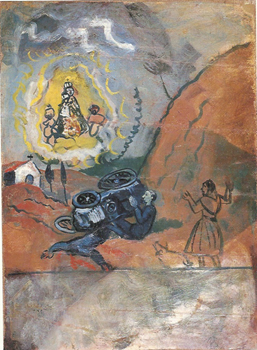
“A genius without a pedestal”: Michel Leiris used this expression in 1988 in the penultimate of the many texts that he wrote about Picasso.
Four sections frame this exhibition:
|
1 |
Picasso and everyday life: roots |
|
2 |
Cherished themes and objects |
|
3 |
Techniques and their appropriation |
|
4 |
The object-material: assembled sculptures |
Picasso and everyday life: roots
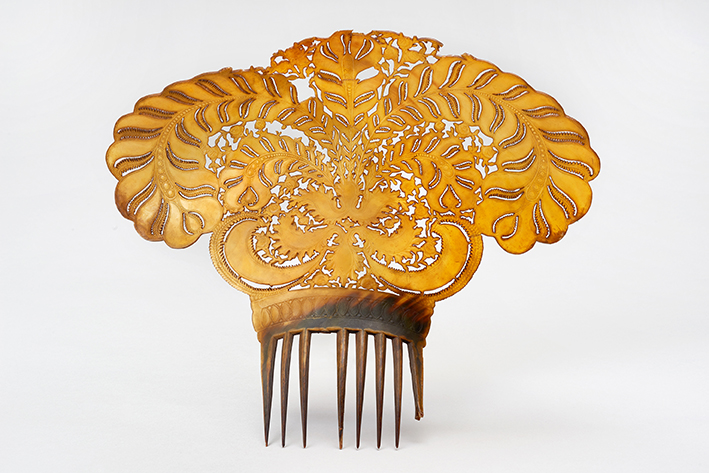
In Picasso’s work, especially in compositions from his youth, daily life imposed itself as an essential theme and environment. Yet later, as the artist reflected upon his memories and integrated them into his vocabulary with the hindsight of passing time, he rendered sacred these marks of a past he knew was over, but to which he attributed an essential part of his own construction. Thus reclaimed as roots, along with learning and academic knowledge, these subjects and techniques obviously took on an entirely new dimension than mere evidence of a restorative nostalgia. For example, even in the world of painting, knowledge of popular ex-votos was expressed very early, like the small ex-voto from the Museu Picasso Barcelona (exceptionally on loan for this exhibition). These overt references to popular arts and traditions, still very much alive at the dawn of the 20th century, impose the force of their ambition opening an exhibition itinerary that in turn outlines the thematic fields and the technical applications of this inspiration.
Cherished themes and objects
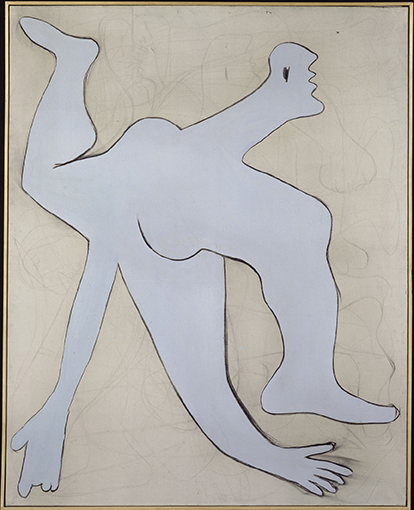
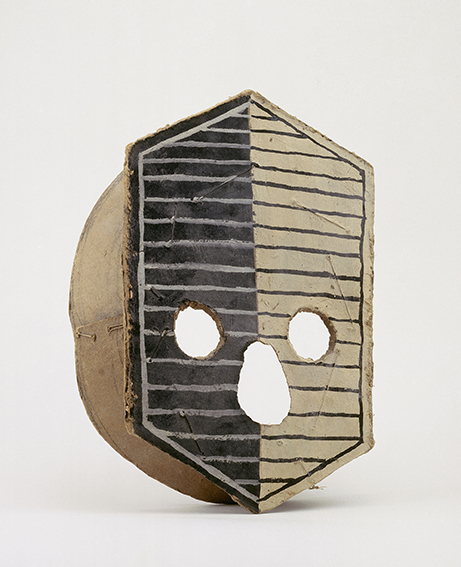
Popular hairstyles and costumes
Even late in Picasso’s career, many portraits contained elements of traditional costumes. Surrounding the emblematic mantilla, the motif of women’s headdresses abounds in his painted, drawn, and engraved works. The woman thus adorned, claims the status of icon of Hispanidad. And while taking advantage of the wonderfully graphic opportunities afforded by lace and netting, Picasso also knowingly entered into this material game with a perfect understanding of the social codes that these accessories signal, evoking in turn the modesty of virgins in white veils and the seduction of the gazes piercing through the black arabesques of the curving patterns. On a different and now masculine note, early on Picasso appropriated the barretina, the traditional hat indelibly inscribed in the virile image of popular Catalan mythology, to construct remarkable cubist portraits that are thus enlisted in the primitivist quest and drawn, moreover, to the stimulating energy of African art.
Musical instruments
The guitar is of course a motif of Hispanic identity and the icon of popular music that accompanied the childhood, and later the bohemian youth of Picasso in Barcelona. It is the source of essential works such as the cubist collages and was certainly among the emblems that inspired the artist, and which he evoked throughout his career. A three dimensional object, a painted motif, the favourite possession of the acrobats who populate Picasso’s work, the guitar is not alone in this silent orchestra. The mandolin, for example, appears frequently as in the superb construction that the Musée Picasso Paris agreed to lend to the exhibition.
The circus
The importance of the circus in Picasso’s work is a given that was established very early and which perennially inspired the painter. A veritable event and popular gathering, this spectacle aroused in Picasso an enthusiasm that was never extinguished and appears in very technically diverse creations. The figures of acrobats in the rose and blue periods would mark all circus iconography of the 20th century by emphasising this plebeian aristocracy, a strong and new image. The motif of the ring and the rituals of the traveling show clearly echo the world and space of bullfighting ring. With Picasso, tied to the circus there is a whole host of masks and popular parades that span the artist’s work. And while the theme of the circus tent and its implicit bohemia haunt all of modern painting in the wake particularly of impressionism, in Picasso’s work it takes on an exceptional magnitude.
Bullfighting
A truly representative and iconic motif of eternal Spain, of Spain the martyr and Spain forsaken, bullfighting takes on, especially from the 1930s and after World War II, an essential role in inspiring Picasso. This true rite of Hispanidad – and thus of the artist’s identity– is at the heart of this itinerary, with all the richness of the techniques (painting, sculpture, drawing, engraving, ceramics, posters…) that Picasso used to evoke and invoke it. There are obviously many works evoking the bullfighting scene as a ritual and creative space, but others address this or that detail of the tradition, taurine movements or construct a veritable gallery of portraits of the toreros. This ensemble constitutes almost an exhibition within the exhibition by focussing on Picasso’s attachment to these dramaturgical rendezvous for which he even created a tradition in Vallauris, with its posters, its media gatherings and its guests, until the final sequence and its illicit killing. In this presentation, the lovely film by the ceramicist Robert Picault (1919-2000), designed with Picasso and nourished by his cut-outs, creates a very effective animation of poetry and invention.
The toys
For each of his children, Picasso made toys in a variety of materials. The toy is also a signifying material element that appears in portraits, often by employing very simple objects, like the traditional pull toy, a horse in wood and paper mache. Family collections preserve often moving evidence of this interest in the playful and the world of childhood. Some cut-outs, for example, with their feigned naivety, seem almost like the drawings of children with the active use of coloured pencils. Moreover, these games and toys can be the echoes or resonances of other works by the artist, especially in the world of sculpture. Thus Lionel Prejger, evokes in his memoirs that the first sculpture in metal that he made with Picasso was a horse on wheels, from pipes, that the artist intended for Bernard, his grandson. And for one of his most famous, constructions, Baboon and Young, Picasso used his son Claude’s small cars to construct the animal’s head. Such works bring forth this formal question of the utilisation of objects or technical gestures from daily life in the statuary creation that concludes the exhibition itinerary.
Pigeon keeping
The appearance of the dove in the political imagery of the Cold War is certainly linked to Picasso’s involvement in the French Communist Party. And the success of this icon contributed lastingly to creating his image as a popular artist. But this motif can also be tied to the widespread tradition of pigeon keeping in Spain. A work by Picasso’s father, depicting in a very naturalistic style the interior of a dovecote, anchors this subject in the Spanish childhood of the painter and, at La Californie, in the hills of Cannes the artist built his own dovecote, the source of a remarkable series of canvases now held in Barcelona. During the same period, cutting soft slab like sheets of paper, Picasso constructed pigeons in folds, a sort of Japanese origami. Other birds were born from deforming, both rapidly and accurately, soft bottles that Jules Agard had just turned in the Atelier Madoura.
Techniques and their appropriation
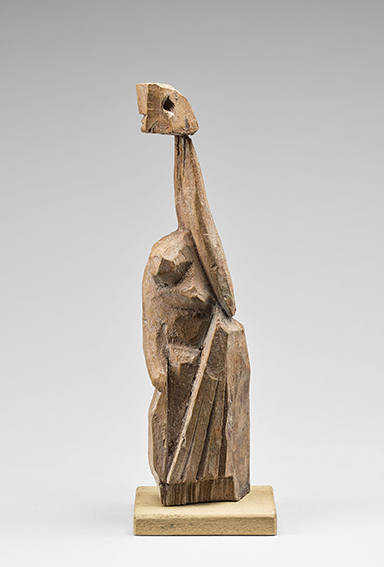
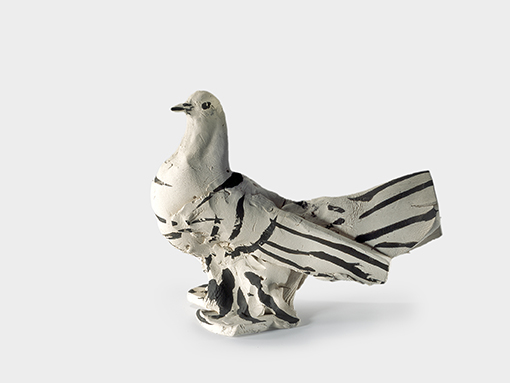
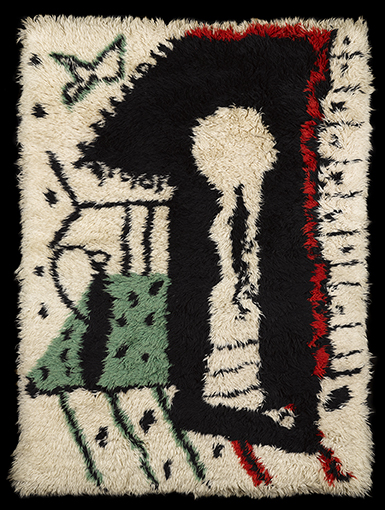
Particularly in the years following World War II, Picasso, on the occasion of fortuitous or intentional encounters, became interested in techniques that nourished his artistic research. Interestingly, each of these shared adventures, with a craft or a very specific profession, is linked to a person or workshop from which Picasso knew how to both educate and liberate himself very quickly.
Wood
Marked by his youthful encounter with Paco Durrio (1868-1940), Picasso long remembered the work of Gauguin that was introduced to him by his Basque friend. Those in wood are undoubtedly the part of this heritage that most affected the young Picasso. A few old pieces are still preserved and perfectly illustrate the roots of this dream of “art in everything”. In addition, at the Musée Picasso in Paris, a little known ensemble of works in wood carved with a knife invites disturbing perspectives with so-called shepherds’ art (canes, small objects…) that Picasso certainly must have known, especially after his experiences in Gosol and Horta that subsequently opened the way for cubism.
Ceramics
Utilitarian ceramics (pottery) were part of Picasso’s childhood environment prior to the arrival of manufactured metal utensils and containers. Very early on, the artist made painted plates and tiles and even decorated his first pignate upon arriving in Paris. In the 1920s, with Jean Van Dongen, the idea for a series of decorated vases confirmed his true interest. In the late 1940s, Picasso began working at the Atelier Madoura hosted by Jean and Suzanne Ramié, in Vallauris on the Côte d’Azur, a small communist city with a pottery tradition dating back to antiquity. It was there that he created his body of ceramic work, rich from the thousands of references, which would definitively shake-up the world of ceramic art. To emphasis the anchoring of this work in clay in origins remerging from the ancillary forms of his childhood, Picasso rendered certain sacred, using them repeatedly. Examples include the pignates that he covered with patterns from antiquity, the pans that he transformed into theatre masks, the gazelles or kiln shelves on which he painted portraits evoking those from Faiyum Egypt, the gourdes or gus transformed into strange insects, and tomettes - floor tiles as supports for ancient or bullfighting scenes. Elsewhere, true two-sided sculptures continued the major Picassoan themes of the moment like the owl. In these sacralisations of popular references, the relationship to the earth is often particularly strong and obvious. Another aspect of this work seemed to toy with the production of ceramic-souvenirs which then animated the stalls of Vallauris with their flashy enamels that Picasso appropriated for example in his constructions of fish on traditional Louis XV shaped plates. A practically unknown set of bevelled plates, decorated like quaint souvenirs of the potters’ city, also reflects these surprising resonances.
Silversmithing
The tradition of silversmithing, inherited from the Arab-Andalusian past, holds an important place in Spanish crafts. An encounter with silversmith François Hugo who had an atelier near Aix-en-Provence associated with artists and fashion designers, enabled Picasso to create a remarkable ensemble of large dishes and fruit bowls or compotiers in silver decorated using the technique of repoussé metal. This sequence immediately followed the evocation of ceramics, because the two experiences are related. Indeed, the large silver dishes have their equivalents in white earthenware produced by Madoura. But the change of material induces a real shift that proves, in a spectacular manner, the porosity between these forays into the world of crafts and the gestures of the artist, engraver or even sculptor.
Linocutting
Already mentioned in the sequence devoted to bullfighting with a few posters produced for Vallauris’s bullfighting season, this technique was used by Picasso, particularly in the atelier of Hidalgo Arnéra, whom he also met on the Côte d’Azur. An entire set of posters for the annual ceramics exhibitions in Vallauris is particularly striking, at the same time that they appear with their regularity, to be enlisting Picasso into the artisanal community of Vallaurian potters. In fact this technique, through the effects of colour contrasts, is built upon the legacy of xylography or woodcuts. Approaching an ensemble of popular imagery, Picasso’s linocuts admittedly express this debt, but they also demonstrate all the daring of an artist who transforms without restraining his model.
Textiles
Closely related to engraving in the effects of colourful planes that he arranges with very simple and often monochromatic designs, Picasso’s work in the art of carpet weaving, which he tackled in partnership with the atelier of Marie Cuttoli (1879-1973), constitutes a very bright and ambitious ensemble. The interesting perspectives make it possible to tie this production to the world of popular carpets – for example the Moroccan Boucherouite rugs – with their simple dyes, colourful variations and material effects.
Metal and concrete
Les rencontres avec Lionel Prejger et avec Carl Nesjar vont susciter chez Picasso une extraordinaire production de sculptures en tôle découpée et en béton gravé. Dans leur simplicité de graphisme et de mise en œuvre, ces sculptures jouent de ressemblances troublantes avec les nouveaux supports de la publicité qui envahissent alors l’espace public et dans lesquels certaines de ces œuvres trouvent parfois leur aboutissement, dans des proportions alors ambitieuses, voire monumentales.
The object-material: the assembled sculptures
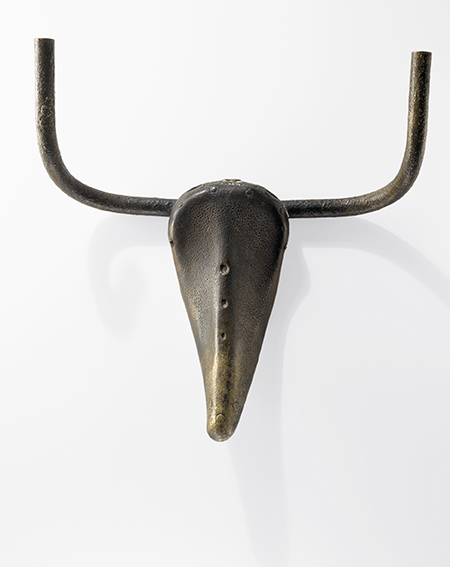
During his years in Vallauris, Picasso made a large number of assembled sculptures, or constructions, according to principles that he had already initiated before the war and that subsequently revolutionised the world of three-dimensional art. Some of these works appear in the thematic sections (for example Bull’s Head for bullfighting, Baboon and Young for toys) but it seemed interesting to build, to conclude this itinerary, a true gallery of constructions, which are easily identifiable, the objects gleaned and the materials recycled. In this Picassoan museum, these sources of prosaic inspiration give the exhibition a spectacular and significant end with this iconoclastic ennoblement of pipes, baskets, jars, toys… given a new life. A fine echo of the views the Musée National des Arts et Traditions Populaires, dedicated to collections until then ignored and even scorned, offered visitors during the same period.
Commissariat de l’exposition
Joséphine Matamoros
Chief Curator of Heritage, former Director of the Musée d’Art Moderne de Céret, Director of the Musée d’Art Moderne de Collioure.
Joséphine Matamoros directed the Musée d’Art Moderne de Céret from 1986 to 2012, the Musée d’Art Moderne de Collioure since 1987 and guided the renovation and expansion of the Musée de Céret. She spearheaded an international and trans-frontier cultural policy, thus giving great clarity to the history of the plastic arts focusing on Céret, Collioure and Cadaquès, three cities that hosted the greatest artists of the twentieth century: Picasso, Braque, Juan Gris, Soutine, Chagall, Matisse, Derain, Camoin, Marquet, Survage, Dali and Duchamp. She continues to explore this subject of study and research through publications and cultural activities. She has organised and curated numerous exhibitions of modern and contemporary art, including: A. Herbin, Antoni Tàpies, Raoul Haussman, Bernard Pages, Ben, Claude Viallat, Joan Brossa, Richard Serra, Joan Mirò, Simon Hantai, Shirley Jaffe, Chaïm Soutine, Sarkis, Raoul Duffy, E. Pignon, Vincent Bioulès, Riera i Aragò, Léopold Survage, Marc Chagall and in particular on Matisse and fauvism, and Picasso and cubism.
Bruno Gaudichon
Chief Curator of Heritage, Curator of La Piscine-Musée d’Art et d’Industrie André Diligent in Roubaix.
Joséphine Matamoros and Bruno Gaudichon were co-curators of the exhibitions Picasso. Objets de Peintre / Peintre d’Objets in Céret and Roubaix in 2004, and Picasso Céramiste et la Méditerranée in Aubagne, Sèvres and Washington in 2013, 2014 and 2015.
Emilie Girard
Curator of Heritage, Director of the Centre for Conservation and Resources of the Mucem.
During her studies in art history and ethnology, Emilie Girard specialised in late antiquity and began research on the Egyptian Bible and its different Coptic versions. Curator of Heritage, she joined the team of the Mucem in 2006, upon graduation from the Institut National du Patrimoine. In 2008, she became the director of the collections department of the museum where she was in charge of the transfer from Paris to Marseille of all the collections and holdings, as well as developing the Centre for Conservation and Resources (CCR), which she currently directs and for which she coordinates the program of temporary exhibitions. She has participated in the curation of several Mucem exhibitions (Gallery of the Mediterranean, Food…) and is also in charge of the “Beliefs and Religions” section of the museum. As such she has published several articles devoted to the religious objects in the museum’s collections.
Scénographie
Jacques Sbriglio
Jacques Sbriglio is an architect and urban planner. He directs the Sbriglio agency, architects established in the heart of the Aix Marseille metropolis.
Among its different sectors of activity, like urban planning and architecture, this agency has numerous references in France and abroad in the field of exhibition design. These include: Arteplage de Neuchâtel in Switzerland (2002), as well as a series of exhibitions on the work of Le Corbusier, whether in Austria (1998), Taiwan (2002), India (2007), Brazil (2009) and most recently in Marseille (2013) as part of the Capital of Culture year. A professor in architectural schools, Jacques Sbriglio is the author of numerous books, articles, and lectures on modern and contemporary architecture.
www.sbriglio-architecte.fr
“Picasso led viewers to examine the internal coherence of his art. Instead of organising his work to trace the evolution from one distinct period to another, he blurred the trajectory, first by contradicting any simple progression, and by drawing attention both to the remarkable consistency of the subjects and the variety of his interpretations… We can say that the hanging was in itself a work of art”.
Michael Fitzgerald, regarding the Picasso retrospective he organised himself at the Galerie Gorges Petit in Paris in 1932. Quoted by Pierre Daix in Pablo Picasso, Editions Taillandier 2007.
Presenting Picasso in Marseille and moreover, at the Musée des Civilisations de l’Europe et de la Méditerranée, has several significations. The first concerns the biography of this painter who, from Malaga via Barcelona and the Côte d’Azur, selected this chosen land, the Mediterranean and its light, to develop a significant part of his work. Secondly, as Pierre Daix indicates, a particular link ties Picasso to Marseille where accompanied by Braque in 1912, he visited the city’s numerous colonial boutiques in order to purchase African masks and other objects of “negro art”, whose influences are found in the paintings that he produced in the years that followed. But beyond this preamble, imagining a scenography around the work of Pablo Picasso is a daunting task, as this work, so celebrated for years and years, requires a frame in which no formal extravagance is allowed, nor any effect of materials or colours. Indeed, the power of expression of these works is such that they speak for themselves, thus forcing the container to disappear behind the content. To do this, the scenography proposed here for the theme “Picasso and Popular Arts and Traditions” takes its meaning from three key ideas. The first is to construct an itinerary that resonates with the architecture of the Mucem, which is designed on the principal of a ziggurat linking the port to the city. The second sequence takes place throughout the exhibition with the implementation of a series of spatial icons defining the framework of each section. The third offers a sort of intersecting portrait, crossing between the works of Pablo Picasso and the reference objects from the collections of the Mucem, without the visitor ever confusing them.
Regarding the lighting environment for this scenography, it extols white in contrast to the twilight ambiances of the Mucem’s spaces but also in reference to the work of Picasso which has wandered through every stage and even beyond, that which we today call: Modern Art.
Four sections organise the tour of the exhibition.
The first, which corresponds to the opening sequence, entitled: “Roots Rendered Sacred”, recalls the links between Picasso’s work and popular rites and traditions. It is symbolised here by a space conceived as a small oratory.
The second, “Cherished Themes and Objects” in reference to the themes of music, the circus and bullfighting… so present in the painter’s work… is dominated by the circular shape of the arena and / or the ring that represents the centre of gravity of the overall composition of this scenography.
The third, called “Techniques and their Appropriation”, is a suite of spaces ordered around the ceramics that constitute, by the sheer number of objects presented, one of the major sections of this exhibition.
Finally the fourth and last section, “The object-material” is presented in the form of a large sculpture gallery, opening onto the Mediterranean, visible through the lacework of the Mucem’s facade, like a final nod to the mantilla, so dear to Hispanic culture. Jacques Sbriglio — Architect scenographer
Partners and sponsors
With support from the La Fondation PwC France et Afrique Francophone pour la Culture et la Solidarité, founding sponsor of the Mucem
In partnership with : BFMTV, Air France, Renfe SNCF, Le Figaro, Trois Couleurs, France Bleu Provence, France Inter
